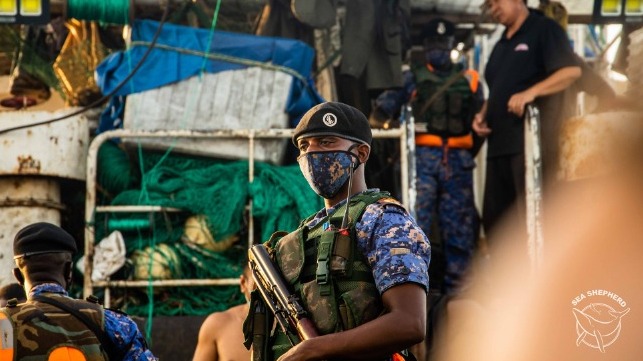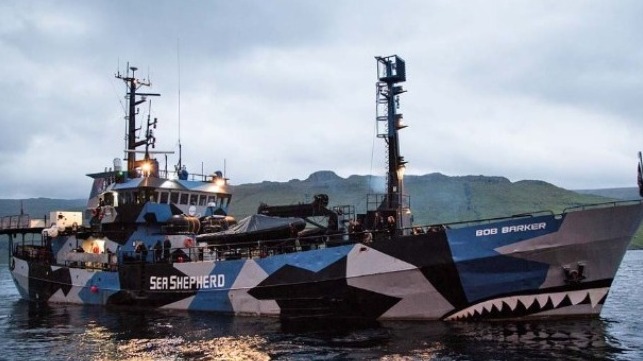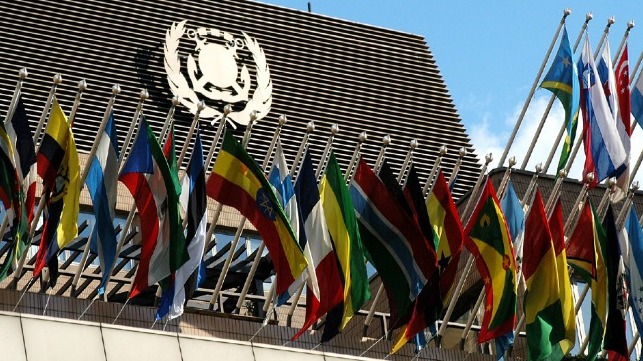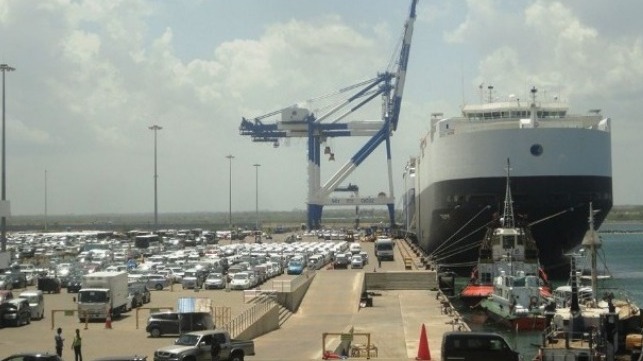Sea Shepherd's Law Enforcement Campaign Secures Arrests

Environmental activist group Sea Shepherd is seeing success in its new law enforcement role off the coast of West Africa. In partnership with national governments, Sea Shepherd is conducting fishery patrol missions and delivering government boarding teams to suspect fishing vessels for inspections at sea - and securing arrests.
On November 4, Gambian law enforcement and military personnel aboard the Sea Shepherd vessel Sam Simon raided three trawlers that they found fishing inside protected waters reserved for artisanal fishermen.
The fishing trawlers Gorde 105, Gorde 106 and Gorde 107 were boarded, arrested and escorted to the Gambian port of Banjul. Two of the trawlers, Gorde 105 and Gorde 107, were also "double-bagging" their net - the act of fishing with one net inside of another one - so as to get around minimum mesh size requirements, another offense under Gambian fisheries regulations. Three days later, the team also arrested the fishing vessel Xing Xi Wang 1 for fishing with the wrong mesh size.
The Gambia has created a nine-nautical mile Special Management Area to conserve a segment of the nation's sardinella fishery for artisanal fishermen. However, industrial trawlers routinely come close to the shoreline, depleting the fishery and running over artisanal fishermen's nets, according to Sea Shepherd.
"At-sea patrols are needed to ensure compliance as well as deterring industrial trawlers from entering protected areas," said Mar Casariego, the captain of the Sam Simon.
Sea Shepherd's patrol ship Bob Barker (a former whaling vessel) recently helped Beninese authorities carry out a similar bust, spotting an unauthorized fishing vessel in a reserved artisanal fishing area and tracking it back to port for interdiction and arrest.
Since 2016, Sea Shepherd has been working with the governments of Gabon, Liberia, São Tomé and Príncipe, Tanzania, Benin, Namibia and The Gambia on joint fisheries enforcement patrols. To date, these partnerships have resulted in the arrest of nearly 60 vessels for IUU fishing and other violations.
Sea Shepherd Vessel Approached as Pirates Grow More Brazen

Security experts recently warned that it was likely that there would be an increase in sea piracy activity in the Gulf of Guinea as the seasonal weather improved in the region. Since that warning, there have been five reports and while the ships have escaped incident crews are being warned to remain on high alert because of the high level of danger in the region.
Maritime security company Dryad Global warned that it believes two or more groups are active, especially in the area near Cotonou, Benin, but that the situation is continuing to evolve as the perpetrators react to opportunities and efforts to increase security. Both the Beninese and Nigerian navies are operating on high alert. According to Dryad, these groups appear intent on kidnapping seafarers that they can hold for ransom.
Last weekend, an Italian Navy frigate came to the rescue of the product tanker Torm Alexandra as it was being approached by a small boat in the Gulf of Guinea. Hours later, another tanker also reported an approach by a boat with seven armed pirates. In this instance, armed security guards aboard the vessel were successful in chasing away the pirates before they could attempt to board the tanker.
Yesterday, the Marshall Island flagged M/T La Boheme also reported that it was approached by two skiffs. The crew mustered in the vessel’s citadel while the master was successful in evading the boarding through a series of maneuvers. Praesidium International offered some additional details on the defense saying that the crew fired distress flares at the two speed boats helping to chase them away after they came within 40 meters of the tanker.
“Whilst the pirates retain both the capability and intent to target larger vessels, it is highly likely that smaller vessels presenting more opportune targets will become more desirable as time goes on and the risk to the perpetrators increases,” said Dryad in its security alert.
There is evidence that the attacks are becoming more brazen and less discriminate in the region as well. In the same area, hours before the tanker La Boheme was approached, Sea Shepherd, the international ocean conservancy movement active against illegal fishing had one of its vessels targeted. The 5,000 gross ton Bob Baker, a retired Norwegian whaler that carries a crew of up to 36, was approached approximately 100 nautical miles from Cotonou.
According to Dryad, seven or eight armed individuals approached the 170-foot vessel coming within one nautical mile of the Bob Barker. The Barker has a speed of up to 15 knots and was carrying armed guards that fired warning shots. They were successful in chasing away the skiff.
Praesidium reports that in at least one instance a tanker was running in “stealth mode,” meaning that it had turned off its transmitting equipment but still was the target of an attack. Praesidium cites this instance to highlight that the technique is not necessarily effective as the attacks appear opportunistic. Authorities in the region have also been seeking to crackdown on vessels using this technique. Last month, it was feared that a vessel had been attacked after its signal disappeared only for it later to be discovered that the captain had purposely disabled his AIS signal.
The increased number of approaches has led to calls to increase patrols in the region while the security services continue to warn of the dangers.








